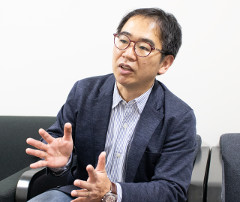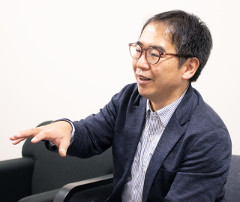Three spheres of social recognition

The term recognition means acceptance in this context. To recognize what someone says is to listen to and accept it.
The same holds true for people. In our daily lives, we regularly accept others and are accepted by them.
Social philosopher Axel Honneth, who has developed a unique social theory centering on the concept of recognition, proposes a two-level account of interpersonal recognition. At the first level is the most fundamental level of recognition, which is to accept people as humans or – their very existence.
We tend to show respect for total strangers, people that we have met for the first time, rather than treating them with little regard as if they are things or animals. This is because we accept people as humans.
This fundamental level of recognition is referred to as elementary recognition.
In reality, however, we might behave as if people around us are not humans in the flesh. We might even pretend not to see them even if they are right in front of us. When we get off of a jam-packed train, for example, we may silently push our way through the crowd around us as if they are simply things and not humans.
This can be attributed to two special conditions that are often common to city dwellers. One is the overconcentration of people in small and enclosed spaces, and the other is that passengers are desperate to get off at their destination stations.
Building on elementary recognition – the fundamental recognition of the very existence of people – is the second level of recognition, social recognition, which is more complex than the first level of recognition.
Social recognition can be divided into three spheres, and social relations can be divided along these lines.
The first sphere is a society based on love and friendship, where social relations are primarily based on families and close friends.
The second sphere may be what is generally thought of as civil society, where social relations are primarily based on freedom and equality. In this public sphere, everyone is free and equal. This is guaranteed by law as fundamental rights.
The third sphere is values-based community, where its members are bound by a specific set of values. This sphere includes local communities, which are made up of people who share traditions and local culture. Yet it also includes what may seem to be the complete opposite – a society held together by economic value and profit, most notably enterprises.
Recognition in these three social spheres differs qualitatively.
For example, human relations in a society of love do not fundamentally expect equal reciprocity. Parents do not love and raise their children in return for a quid pro quo. Recognition is unconditional in this sphere.
By contrast, human relations in enterprises and other values-based communities are based on competence, efficiency and value to a society or local community. People of great competence and those whose social contribution is great are highly valued and welcomed by the value-based community concerned. In other words, individuals’ performance or competence constitutes a condition for recognition.
Suppose parents accept their children if they are overachievers but reject them if they are underachievers in line with the rules of recognition in this particular values-based community. What would these children feel?
Conversely, what would happen in an enterprise if a boss valued an incompetent subordinate because the boss likes the subordinate?
Or what would happen if an enterprise treated both high- and low-performance employees equally in the belief that everyone should be equal in civil society? Wouldn’t high-performance employees feel that they are being treated unfairly?
The point is that mixing up different types of recognition peculiar to the three social spheres constitutes mistaken recognition and could lead to non-recognition.
Non-recognition, in turn, causes the feeling of being treated unfairly, which can develop into anger or sadness.
Non-recognition undermines self-identity
Non-recognition is caused not only by the mixing-up of the different types of recognition: it could also be caused when people who have mastered the rules of recognition ignore others or pretend not to see them as a result of the current or local prejudice or authoritarianism. This state of affairs has long existed; racial discrimination is a typical example.
In pre-civil rights America, for instance, even elementary recognition was not given to African Americans.
Even today, there is a serious situation in which people are not socially recognized.
Examples include the inappropriate attitude or behavior of the majority toward minorities over LGBT or SOGI (sexual orientation and gender identity), an unjust evaluation of people who are regarded as the working poor, and an exclusionary attitude toward persons with disabilities or biased sympathy that seems to contain empathy but is really laced with prejudice.
Also at the root of power harassment, sexual harassment, bullying, and child abuse – all of which have been objects of social concern in recent years – is a substantial gap in power or status between the perpetrators and victims, or at least an illusory gap that the former arbitrarily set up in order not to regard the latter as members of their society. This is an attitude that is unwilling to accept the latter, that is, non-recognition.
How does non-recognition affect people? As discussed earlier, it causes feelings of being treated unfairly, which can develop into anger or sadness.
The feeling of anger or sadness may in turn develop into the struggle for recognition. Examples include the civil rights movement against racial discrimination in the past and the LGBT movement and the Me Too movement in recent years. Honneth thinks of the struggle for recognition as a source of social development dynamics. What he means is that revamping old habits and preconceptions can lead to the establishment of new rules of recognition.
Yet such transformation may take some time. The feeling of anger or sadness may not seem legitimate even to those who have that feeling. Even if it seems legitimate to them, they find it quite difficult to find the rationale for sharing that feeling with others.
In a society where a culture of argument has not been established, like Japan, simply questioning an idea may invite an overreaction – let alone objecting to it. Under such circumstances, non-recognition often backfires. In the cases of non-recognition that we see or hear in our daily lives, anger or sadness often develops into anguish, driving the sufferer into a corner.
It is extremely difficult for children who are not accepted in a society called family to be able to feel that they can be accepted in a free and equal civil society.
This is because they fail to build self-confidence in the process of developing into adulthood and lose faith in themselves. As a result, they become unsure that they are allowed to stay in this world.
At a different level, non-recognition is also happening to children bullied at school, people who are regarded as the working poor, and employees who experience power harassment at slave driver companies.
Let us look at this in light of the three types of social recognition. Cases where people are physically abused by other members of the society to which they belong, those where they are not given freedom or treated equally, and those where their achievement, competence, and individuality are underestimated without reason, are all examples of non-recognition or misrecognition.
Also at issue are cases where people feel that others do not see them, though they are in a way glaringly conspicuous, and where people are in obviously excruciating situations but others pay no attention to them. Such anguish, which can be described as the type of anguish that an invisible person would feel, may prompt the sufferer to ask themselves, “Do people around me treat me like this because there is something wrong with me?”
Yet, what if people who recognize such person have something to be desired or even misrecognize him/her? His/her identity, with which there may have been nothing wrong, may be disfigured. He/she may be overwhelmed by existence anxiety, a weak sense of belonging to society, a lack of interest or sense of responsibility, or low self-evaluation.
Toward a society where people can empathize with the pain of non-recognition

Why don’t people rightly recognize others as members of the society in light of their social situation and in accordance with appropriate standards of recognition? Why can they continue to disregard or exclude others?
First and foremost, these things happen when the rules of recognition in the society in question are misinterpreted or deliberately distorted because the existing goals or habits are given priority. Such misinterpretation or distortion gives rise to a sense of false solidarity that permeates society.
Next, such solidarity is problematic also because it inhibits the workings of our sensibility to empathize with the pain felt by people who are not rightly recognized, and because it justifies our failure to empathize with it.
The inhibition of sensibility first manifests itself in people who behave as if they do not recognize others appropriately. Then it leads us to fail to appropriately understand the situation of people who suffer from non-recognition or misrecognition and their complaints about their situation.
The result of all this is that although minorities who are discriminated against, as well as the sufferers of power harassment, bullying and abuse, who are in excruciating pain, empathy with the hardship they are experiencing is not adequately shared, or there is little such empathy in the first place. Accordingly, these problems remain largely unnoticed and fail to emerge as a major social problem.
The real problem is that once false solidarity is established between people who are not given recognition and those who give it, the logic of self-responsibility sets in. The advocates of this logic may argue that the bullied are to blame for being bullied or that the working poor are in the position that they are in as a result of their failure to simply work harder.
This gives rise to the logic that denounces and suppresses any attempt to object to non-recognition. As a result, we become insensitive to the unreasonableness of this logic. Furthermore, even the sufferers who are angry about non-recognition and those who have a measure of empathy toward them might come to internalize this logic.
In this case, the sufferers face double anguish: anguish stemming from non-recognition and anguish stemming from a guilty conscience about the situation they are in.
Why has our capacity to empathize become diminished? This might possibly be because the values of capitalist culture have come to exert too much influence on other parts of our life domain.
The values originally shared in enterprises and other values-based communities, such as efficiency and economic performance, have filtered into every aspect of society.
To clarify this point, let us take the example of how the expression “become a useful person” has undergone a change in meaning. Children have long been taught to “become a useful person” by their parents and the adults around them. The term “useful” should have multiple meanings. The expression may mean “become a person useful to society.” But it could also mean “go and help people in need” or “work with other people to build this society.”
It seems to me, however, that this expression is now essentially interpreted to mean “become a person who creates economic value.” There seems to have been an irresponsible change in logic. The value of a person should be evaluated on the basis of multiple criteria. Unfortunately, however, there is now a strong tendency to use the single criterion of productivity in terms of simple profit or interest.
There is also a growing tendency to define a good society as a society where each member has entrepreneurship.
That is an important idea or value. Yet it seems to me that multi-dimensional values have been replaced by single-dimensional values and have not been accepted in a society. I am sometimes dumbfounded by my students’ strong expectations or requests based on such values when teaching at a university.
People should not be overwhelmed by capitalist values, which stress, among other things, the need to win in a competitive society in order to be economically successful; they should maintain their empathy with others and their interest in sharing such empathy. Otherwise, other elements that support the economic realm of society will likely be undermined in the long run.
Can a society that disregards social welfare and social security systems and leave the vulnerable and the elderly behind really achieve economic growth? Should such reciprocity-based systems disappear in the future, a mechanism would also disappear whereby decently rich people appear from many different social strata.
The era in which enterprises and the rich become richer may continue, but Japan may shrink as a society, making further development impossible no matter how hard we try. Now we may be so myopic and confined to short-term thinking that we cannot to conceive of such a gloomy scenario.
Nevertheless, a glimmer of hope is that diversity is becoming a buzzword for the times, even though we still have a long way to go before its value is actually realized. Objectively, people living in Japanese society are becoming increasingly diversified. The need to meet such diversified need is growing and attracting public attention.
A case in point is a growing move to promote inclusive education, which provides more opportunities for children with disabilities to enroll in ordinary schools. This provides greater learning experiences for children with and without disabilities alike.
Another stark difference that I have noticed from when I was a child is that it is no longer rare to see pupils with many different backgrounds in elementary school class rooms. Accordingly, municipal governments voluntarily offer international exchange programs and language classes, including Japanese classes, to non-native speakers of the language.
In such practical settings, children are beginning to learn diversity in the real sense of the term. We must make sure that such children’s learning will not be undermined with an eye on realizing the value of diversity. Expanding this move among the public will help our society become more sensitive to non-recognition and the anguish of others.
* The information contained herein is current as of February 2020.
* The contents of articles on Meiji.net are based on the personal ideas and opinions of the author and do not indicate the official opinion of Meiji University.
* I work to achieve SDGs related to the educational and research themes that I am currently engaged in.
Information noted in the articles and videos, such as positions and affiliations, are current at the time of production.

